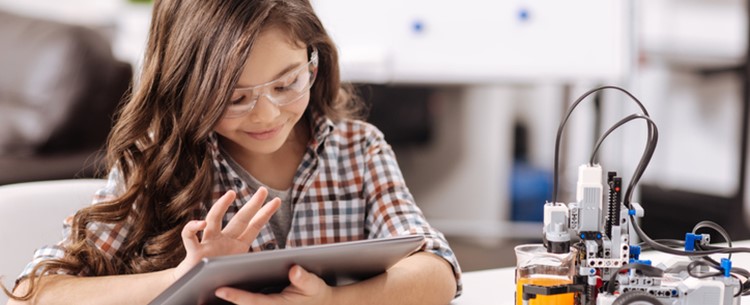By Michael Hilkemeijer
Digital play in early childhood education is the theme from my top online pd for early childhood teachers titled "How to support play based learning in early childhood education with digital technology". You can learn more about it by enrolling in the stand-alone course for $460 AUD or gain INSTANT ACCESS to it by becoming a member of my ICT in Education Teacher Academy for just $5.99 per month (cancel anytime). So you can join, complete the course/s you want and then leave if you wish. OR stay to learn more for a fraction of an enrolment fee today.
Control technology plays a very important part in the early childhood education curriculum whether you use the Early Years Learning Framework or the Early Years Foundation Stage or something else similar. In the past, it has been misunderstood to be a highly gendered set of activities involving complex construction kits of cranes or ski-lifts that may use binary code.
Today, control technology activities with programmable toys in preschool education are taking place which bears no resemblance to this stereotype.
Providing such control technology is essential for the development of ICT capability in preschool. They can be used as a tool in many different ways depending on whether the main objectives are to learn ICT techniques, to develop an understanding of processes, or to apply familiar techniques/processes in learning other matters.
Other reasons why using control technology is significant are that:
- It helps young children to become aware of the digital technologies that surround them in their homes and in their local environment;
- Engaging in control technology activities such as with those programmable early childhood education toys obliges children to deal with and to construct computer programs – this gives young children their most profound insights into modern ICT, and helps to demystify it and make it transparent;
- It may help young children to develop more general capabilities to think and learn – children learn most effectively when they are in control of their own learning and they are allowed and encouraged to play.
The use of programmable toys in play-based learning in early childhood education is based upon the constructionist teaching approach that was developed by Papert (1993). This is underpinned by the idea that learning can occur effectively when people are actively engaged with doing and making things in the real world.
What are the other benefits?
Five key benefits of using programmable toys in the early childhood learning environment include:
- They are affordable;
- Does not provide screen time;
- Does not require electricity;
- Encourages collaboration and interactivity;
- They are programmable toys that are different!
It also:
- Supports creativity – it provides a wide range of responses in young children;
- Provides opportunities to think – they can discuss self-initiated problems;
- Allows systematic thinking and discussion about problems;
- Learn without failure – young children will learn by getting things wrong and value the process in addition to achieving the final goal.
How to start?
It is best to encourage young children to programme each other as robots in a preliminary movement activity. They will enjoy programming toys but beforehand, it is important that they spend time being programmed and giving each other instructions to go from one place to another, exploring direction, distance, and turn.
It will provide an enjoyable movement activity and also will make the transition to using programmable toys much easier.
You will also need to discuss with the children the importance of using precise language and introducing the need to give instructions in sequence.
How to promote higher-order thinking skills?
The main advantage of digital technology use in early childhood education such as control programs is that it involves the construction of sequences of commands. This encourages young children to plan which is a fundamental and unique characteristic of human thinking. It is also an ability that emerges early. Programmable toys, therefore, gives young children “an object to think” (Paper, p. 11) and it does so in a number of ways.
- Programming requires rigorous thinking to be made explicit;
- It provides an environment in which the general concepts of transformation, function and variable can be used and their consequences are seen;
- With problem-solving through programming, it is possible to appreciate the usefulness of heuristic approaches to a solution;
- The interactive process of getting a program to run as intended gives an appreciation of debugging an imperfect solution;
- The vocabulary of programming and the necessity to openly discuss the process of problem-solving during programming, give an awareness of the process of problem-solving. And this gives strength to the control process.
(Underwood and Underwood, 1990 as cited in Siraj-Blatchford and Whitebread, 2003, p.44)
Digital Role-playing with programmable toys
Have you ever thought of what would happen if you dropped a programmable toy into a role-play box? This will give you the opportunity to assess young children in several areas of learning such as:
- Social skills and collaboratively working together;
- The ability to act out and respond to each other in role;
- The ability to create imaginary scenes and scenarios for the programmable toys;
- The ability to program the programmable toy to do exactly what they intended;
- Use of language.
(Morgan &Siraj-Blatchford, 2009)
Get started with these ideas:
- People who help us;
- Turn the programmable toy into a character from a book;
- Turn the programmable toy into a butterfly and visit ‘flowers’;
- Pretend the programmable toy is a school bus and the children need to travel round a map collecting school children.

Preschool Case Study
In this preschool case study from Kaye (2017, p.56-58), the early childhood teacher uses the bee bot to encourage the children to design a set of instructions for it. This has implications for literacy and language development in early childhood education. Read what happens below.
"Rob, a reception class teacher in a primary school, has been given a programmable toy for his class to use. He begins by introducing it to the whole class during a carpet session and the children are very excited by it. He demonstrates how the controls work, picks a couple of children to try it out and says that they will all get an opportunity to use it working in small groups. He has cards with directional words printed on them. He encourages the children to recognise these as ‘sight words’, and they practise raising right and left limbs etc. Later in the day Rob puts the toy in a quiet corner of the room and sets the cards beside them for the children to use.
In subsequent weeks, he will introduce a series of mats that provide scenarios for the children to navigate around, and he will introduce increasingly complex written instructions for the children to follow. As an extension, he later puts wipeboards in the area for the children to write their own instructions."
Conclusion
Early childhood teachers can make a crucial contribution to digital play-based learning in early childhood education by ensuring that young children can develop confidence and an understanding of the fundamentals of control technology such as programmable toys, in order that they develop into ICT capable and digitally literate individuals. Use these examples today to help start a child’s digital learning journey now.
